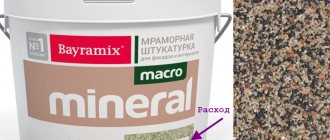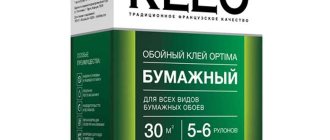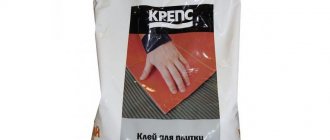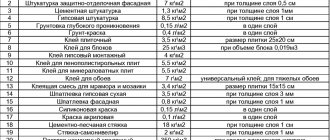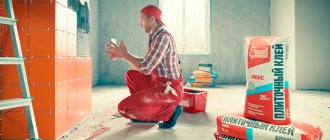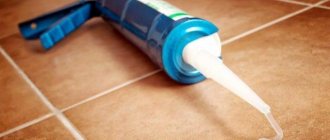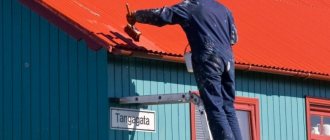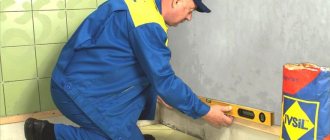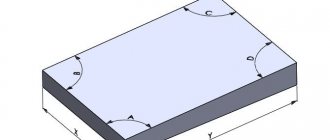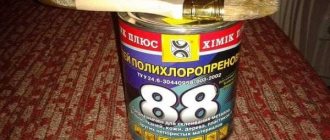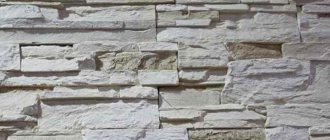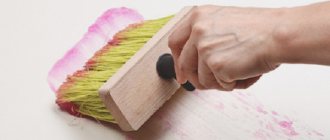To lay tiles you need glue. Perhaps everyone knows this. But how much is needed? 1 bag of 25 kg? 10 bags of 5 kg? Often the decision is made at the last moment at the market or in the store and you have to buy as much as the seller said. Is he right or wrong? In another situation, your foreman buys as much glue as you need (he knows for sure), tells you the number, but you can’t check it. Or you want to plan all the costs of repairs in advance (a useful, but utopian activity) and calculate how much installation will cost you. What to do? How much glue do you need?
First the basics: tile adhesive is usually measured in kilograms. The amount you need is determined as the glue consumption per square meter of installation, multiplied by the total number of meters. Everyone usually knows the laying area, so all that remains is to find out how much glue is needed per square meter. There is no definite answer to this question, but we will help you roughly figure out how much glue you need. To answer this question, you need to know the following:
1) Type of glue
Typically, tile adhesives fall into 3 broad categories: cement-based adhesive , dispersion adhesive , and epoxy adhesive . In the first case, you buy a bag of cement (with various additives) and dilute it with water or a latex additive. This is the most popular option: economical and not difficult to work with. The average consumption of such glue ranges from 1 to 1.9 kg per square meter per 1 mm of glue thickness .
(For example, 1 kg per m2 for Eunice Granite glue, 1.5 kg per m2 for Litokol K66 glue and Hercules Basic glue, etc.) In the second case, you buy a ready-made liquid mixture (resin-based), which does not need to be diluted with anything. In the third case, you buy a liquid resin-based composition and a catalyst. You need to mix both components, a chemical reaction will occur and as a result an adhesive solution will be formed (this is a little more complicated, but this composition is not afraid of water and cold, is not subject to shrinkage, cracking and adheres perfectly to the surface). It is incorrect to compare the total amount of such a mixture in kilograms with the consumption of a cement-based adhesive mixture.
Epoxy adhesive for construction purposes
Epoxy adhesive includes a base and a catalyst that are mixed immediately before use. When using EC, you should remember to increase the amount of substance consumed when the surface is uneven or deformed.
The weight of epoxy glue is calculated as follows:
VEK = Adhesive density x (S tiles + Thickness of the applied layer)
It is important to consider the porosity of decorative parts. Sales consultants will help you correctly calculate the need for materials so that the result meets your expectations.
2) Tile size
Typically, the larger the tile size, the larger the adhesive layer should be. As a rule, for small tiles (up to 10x10 cm) for cement-based adhesives for thin-layer installation, this layer is slightly less than 2 mm. For tiles with sides from 20 to 30 cm, the layer thickness most often ranges from 2 to 3.5 mm, for tiles from 30x30 to 50x50 the layer can be from 3.5 to 4.5 mm and for large tiles, the layer can be 4-5 mm. For large slabs (from 60 cm), it is also recommended to apply a layer of adhesive (about 1 mm) to the back of the tile. The dimensions given are approximate; it is quite possible that you will lay 45x45 cm tiles on a much thinner layer. It is important to take other factors into account.
| About the size of the spatula and the thickness of the glue Most often, when purchasing glue, the technical information for each size of tile will indicate not the layer of glue in millimeters, but the size of the spatula teeth that the factory recommends for application. For example: for 30x30 tiles use spatula 8, and for 50x50 tiles use spatula 12. Not a word about layer in mm. Why is this happening? Because measuring the adhesive layer in millimeters during application is not an easy task, how and with what will you measure? In addition, if you apply an even layer of glue, it is likely that visually it will seem even to you, but in fact it will have differences in height. If you lay tiles on such an uneven adhesive surface, you will most likely end up with air holes in some places under the tiles, which will sooner or later cause the tiles to chip. Therefore, factories recommend first applying the glue with the smooth end of a spatula, and then combing and leveling it with a serrated edge. The most commonly used spatula tooth sizes are 6, 8, 10 and 12 mm. The dimensions of the spatula are predetermined, each factory knows the properties of its glue, so it is much easier to predict the exact layer that you will put. Therefore, you can often see in the instructions the glue consumption in kg, depending on the type of spatula. (For example, for Ceresit CM12 adhesive for 30x30 cm tiles, the instructions recommend using a spatula with 10 mm teeth, and the adhesive consumption is immediately given as 4.2 kg per square meter). However, do not think that when using a spatula with 8 mm teeth you will get an 8 mm layer of glue. 8 mm is the initial height of the ridges that would be left behind by a spatula held at an angle of 90 degrees. But, firstly, you will move the spatula at an angle, and the initial height will be less, and secondly, when you lay the tile on top, it will press the glue and it will be distributed over the entire surface. Typically, the adhesive layer will be in the range of 0.3 - 0.5 of the size of the spatula teeth. For example, for an 8 mm spatula, the glue thickness can be 2.4 - 4 mm. This proportion is approximate, since you can lay the glue at different angles, besides, different glues have different properties and only the glue manufacturer can tell you what height of glue you will get when using a given spatula. |
Determining surface unevenness
So, we know exactly the area to be tiled and we know the recommended adhesive thickness in mm for store-bought tiles. However, it is too early to calculate the glue. It is necessary to take a flat aluminum rule or a long level and walk over the entire surface of the pre-plastered walls or screed poured onto the floor. During this procedure, it is necessary to adequately assess the surface roughness. For example, a rule was set on the edge of the screed and in some places depressions are visible. It is the depth and number of these depressions that need to be assessed. Of course, no one will make such measurements with a micrometer in their hands. Unevenness is assessed by eye. For example, drops and depressions of approximately 2 mm in depth were found across the entire floor area - this value will be considered “zero”. That is, when covering the screed, 2 mm of glue will be required to level the depressions + the minimum thickness of the glue, determined based on the size of the floor tiles. Only in this way will it be possible to determine the actual thickness of the future glue. Advice!
If during the examination of the surface differences of more than 5 mm were revealed, then in order not to overpay for a huge amount of tile adhesive, it is cheaper to level such a surface with cheaper materials. Fill the screed or putty.
We look at the consumption indicated on the bag of glue
Attention!
The above calculation was given only as an example, and a specific brand of glue was taken. In real calculations, you must always look at the flow rate indicated on the bag by the manufacturer.
Calculation option for busy people
Not everyone has practical experience in construction or had the highest grade in trigonometry. However, just the same, everyone wants to know exactly how much materials will be needed for the work and how much they will cost. Sometimes it doesn’t hurt to check the work of the foreman to see if so much glue is really needed, maybe he’s being disingenuous. In all these cases, an online calculator will help out. To automatically calculate the consumption of tile adhesive per 1m2, you will first need to independently find out the dimensions of the area being tiled, indicate the dimensions of the tiles and the brand of adhesive you like. These simple data are entered into the corresponding columns of the online calculator. Press the “calculate” button and the program will immediately give you the exact amount of tile adhesive needed for tiling. The only thing that needs to be taken into account is that over large areas there may be a slight error in the calculation.
3) Type of tile
The back surface of the tile absorbs the adhesive. But different types of material differ in porosity - handmade and cotto tiles are very porous, they absorb more glue. Glazed industrial tiles absorb less, and porcelain tiles absorb even less. Most often, manufacturers produce special adhesives for each type of material, which takes these features into account. But there are also universal adhesives, so you will need to take into account the difference in absorption for different materials. If you are installing stone, manufacturers will often also ask you to apply an additional layer of adhesive to the back of the material.
In addition, it is important to pay attention to the evenness of the back surface of the tile. Handmade and clinker tiles often have an uneven back surface, so it is recommended to apply an additional thin layer of adhesive. This will increase consumption.
If you plan to lay tiles of different thicknesses on the same surface, you will have to compensate for this difference using adhesive. Be prepared for that. that consumption will increase.
Subtleties of application
When working, there are subtleties that should be taken into account:
- The adhesive is spread on the tiles using a notched trowel.
- You should not apply the adhesive mixture directly to a large surface area, as the formation of a dry film will reduce the quality of adhesion.
- The same distance must be maintained between the tiles (crosses must be placed); adjustments to the location are carried out within 20 minutes.
- Excess should be removed immediately after adjustment to avoid later scraping from the face of the tile.
- When laying large tiles or on a “warm floor” system, the application is combined, the solution is applied to the tile and the main surface.
- Use is prohibited within 24 hours after installation.
- The work is carried out subject to the availability of IZ funds.
- If the solution gets on exposed skin or mucous membranes, rinse with running water.
Interesting video on the topic:
4) The base on which the tiles are laid and the technology for laying the tiles
Before laying, you need to know the condition of the surface on which you will lay the tiles. Ideally, it should be an absolutely flat plane, without differences in height. In practice, most often there are 2 situations: in the first case, the surface is as level as possible and the differences in height do not exceed 3 mm. In this case, you can lay the tiles using the thin-layer laying method - this means that the layer of adhesive will be minimal, and the adhesive itself will be intended only to adhere the tiles to the base. Most often, in such cases, the adhesive layer will not exceed 5 mm (and will remain within the limits specified above). But the total consumption of glue in any case will depend on differences in the height of the base and irregularities (which it will fill). In the second case. the surface may be difficult and uneven. There are adhesives that simultaneously level the surface and glue the tile to the base. Usually they can handle height differences of up to 30 mm. This technology is called thick-layer laying and the adhesive layer in this case will be determined by the presence and nature of irregularities and can reach up to 30 mm. Naturally, with this installation method, the glue consumption will be significantly higher. Quite often, this method is used when laying tiles that have strong differences in thickness (for example, this method is suitable for laying clinker with a highly profiled back side and handmade tiles with an uneven surface. If you try to lay such uneven tiles on a thin layer of glue, the consequences will be depressing: the final surface may be uneven, the tile may not stick due to voids, etc.) Accordingly, you must know exactly how you will install it before calculating the glue consumption. The smoother the surface, the less glue will be needed and vice versa. In addition, one should take into account the fact that the bases on which the installation is carried out have different porosities. For example, a relatively porous cement mortar base absorbs more adhesive than a concrete slab, so the adhesive consumption will be greater. And one more thing: when laying on a vertical surface (especially external facades), it is often recommended to apply glue not only to the base, but also to the back side of the tile for better adhesion and to avoid the appearance of voids under the tile. In this case, glue consumption will increase and you should take this into account.
Advantages and disadvantages
Among the advantages of using plitonite adhesive mass, the following are highlighted:
- The solution does not require special preparation; the dry mixture mixes well in water without forming lumps.
- Increased adhesion.
- Low level of slip coefficient from the vertical plane.
- The flexibility of the layer allows you to hold the tiles, preventing cracking when the building shrinks.
- Moisture and frost resistance allows work to be carried out from the street side.
- Availability.
Negative points include:
- The base must be carefully prepared before laying, otherwise the tile layer will move away from the surface.
- The minimum packaging is 5 kg, so you will have to overpay for an unnecessary amount of glue.
5) Brand and composition of glue
Different brands of adhesives contain different additives (to give greater adhesion, elasticity, change the setting speed, resistance to slipping, temperatures, etc.). All this changes the density of the glue, so two 25 kg bags can contain different volumes of material, which, accordingly, changes its consumption. In order to more accurately calculate the material consumption, it is better to know the manufacturer and the name of the glue in order to be able to check its consumption according to the information stated by the manufacturer. (For example, the standard rate of consumption of Eunice Granite glue is 1 kg for each mm of glue, the rate of Litokol K80 is 1.35 kg for each mm. With a glue thickness of 4 mm for an area of 20 meters, the difference will be (approximately, other things being equal) 20 kg (80 kg versus 108 kg). Therefore, if you want more accurate calculations, be sure to look at the manufacturer’s data.
Weight of PVA construction adhesive
PVA glue for construction purposes is capable of gluing various materials: paper, wood, cardboard, leather, linoleum, plastic, laminate, glass and tiles. Convenient for assembling furniture, has significant stability at high temperatures and dynamic loads. Suitable for carpentry processes, does not leave marks and is very elastic.
The weight of pva glue in a packaging container is 0.5 kg. The consumption of the substance is economical - in the range of 100-900g/m². It is inexpensive and moisture resistant. It must be applied with a brush, taking into account the temperature conditions. Can be used to strengthen the adhesive mixture, increase its viscosity and greater adhesion.
Source
6) Weather conditions
The normal temperature for laying tiles is from +5 to +40 degrees Celsius. Ideal - around 18-24 degrees. The higher the temperature at which you lay the tiles, the more water evaporates from the surface of the adhesive and the greater its consumption. At low temperatures (below zero), the glue begins to deteriorate and it is extremely difficult to predict its consumption. It is also important to pay attention to the wind. If you are laying tiles outside, if there is a strong wind, moisture will again begin to leave the surface and glue consumption will increase.
7) Working technique and qualifications of the stacker
The glue consumption depends on how you use the tool. With different angles of inclination of the spatula, the thickness of the applied glue changes (for example, at an angle of 60 degrees, the glue consumption may be greater than at an angle of 45 degrees. The difference can be up to 25 percent). Likewise, trowels with different tooth shapes will distribute different amounts of glue: a V-shaped trowel will typically distribute slightly less glue than a U-shaped trowel, which will in turn distribute less. than a square tooth spatula. If you are laying tiles for the first time, then the glue consumption may differ from the standard due to the fact that you either practice, or break the technology, or for some other reason some of the glue is wasted. In this case, it is always better to buy material with a reserve so as not to stop the installation in the middle of the process.
Humidity and moisture absorption
Two more estimates are worth making when deciding how much solution to apply. This is the humidity of the solution and the moisture absorption of the base. When laying ceramics on a wall, you should not use a semi-dry solution; moreover, the wall must be primed, if necessary several times, until the strong absorption of the surface stops.
With high absorbency, you have to increase the thickness of the glue so that the tile simply does not fall off when it dries. Pouring water will not help much, especially if the base consists of ordinary cement-sand plaster with a low cement content.
When laying ceramics on the floor, a drier solution is allowed than on the wall, but only if the moisture absorption of the floor is low. Therefore, the floor base should also be primed.
Some builders pour water excessively on the walls, on the floor, on everything around, thinking that it will be better, but no, due to excess moisture, the glue loses its properties. You need everything in moderation, as they say.
Calculation of the required amount of glue
How to quickly calculate the amount of tile adhesive you need? There are several ways.
The easiest one is if you know exactly what kind of glue you need. For example, you have been laying tiles for many years and know for sure that you want Eunice 2000 or Mapei Granirapid. Just go to the manufacturer’s website and find the calculator section (such sections are on the websites of all manufacturers). In the calculator, just enter the size of the tile, the area of the room and the brand of glue, click on the calculate button - and you will get a ready answer in kilograms. This figure can then be increased if you know for sure that you will use glue to level the height between the tiles, work in conditions where the back surface also needs to be covered with glue, and under other circumstances that increase consumption.
If you don’t yet know what kind of glue you will use, but want to estimate the cost of repairs, use the figures above. We will assume that you will use cement-based tile adhesive (this is the most popular and simplest option). Then you can take the average temperature in the hospital - glue consumption is 1.3 kg per 1 mm of glue layer. Multiply by thickness. glue. Let's say you lay 30x30 cm tiles on the floor. Then, with an average layer of 4 mm (see the paragraph about tile size), the glue consumption will be 5.2 kg per 1 m2 of installation. If you need to lay 20 meters of tiles, you will need 20 * 5.2 = 104 kg of tile adhesive. If you decide to lay 10x10 cm tiles on the same area, you will need 1.3 * 2 * 20 = 52 kg of glue. If you decide to lay 60x60 cm tiles, then you will spend approximately 1.3 * 6 * 20 = 156 kg of glue
It is important to understand that this value is very approximate, and based on it you cannot go to the store and order glue. Let us repeat once again that adhesives are different, they all have different properties and consumption, so it is better to at least know the brand of glue. But this figure will help you navigate expenses and planning; at least the final result is unlikely to be ten times more or less.
And the third method, which is more suitable for sellers in a tile store. Suitable if the buyer asks to roughly say how much glue will be needed (without details, just for estimation). You need to take half the thickness of the tile in mm and multiply it by the average adhesive consumption per mm of the brand you sell. If you don’t know the consumption or there are several brands, multiply by the hospital average of 1.3. Typically, small-sized industrial tiles are quite thin (5-6 mm), medium-sized porcelain tiles are 10 mm thick, and thicker porcelain tiles are from 12 mm thick. Therefore, for porcelain stoneware 45x45 cm (10 mm thick) we get 5 * 1.3 = 6.5 kg per meter, which will give 130 kg per 20 meters and will be relatively close to the truth. Of course, you can’t issue an invoice based on such criteria, but at least you can name the order. In any case, we advise you to always refer to the recommendations of the adhesive manufacturer, and also keep in mind that the amount of consumption will vary depending on the installation conditions (listed above).
Work order
The work is carried out under the conditions prescribed by the manufacturer (at a temperature of 5–30 degrees), then the layer will dry evenly, ensuring complete adhesion. Put the tiled surface into operation no earlier than one day after installation. This also applies to grouting work.
The tile material is completely cleaned from the working side. The coating that is covered with tiles should not contain unevenness, old material, deformation is excluded.
The surface is puttied to remove cracks and crevices, then primed. It is advisable to buy the primer of the same brand as the adhesive mixture. If the room is damp, then the primer should contain antiseptics and antifungal components.
Glue consumption rate for popular brands
To help you a little with your calculations, we have collected average consumption rates for the most popular brands of glue. More detailed information on each type of glue is listed below, the summary information is as follows:
Unix glue : average consumption rate is 1-1.16 kg per 1 m2 with a layer of 1 mm of glue
Ceresit glue : average consumption rate is 1.4-1.6 kg per 1 m2 with a layer of 1 mm of glue, or from 1.5 to 6 kg per m2 depending on the size of the spatula and the type of glue
Litokol glue : average consumption rate is 1.3-1.5 kg per 1 m2 with a layer of 1 mm of glue, or from 2.5 to 6 kg per m2 depending on the size of the spatula and the type of glue
Hercules glue : average consumption rate of about 1.5 kg per 1 m2 with a layer of 1 mm of glue
Mapei glue : average consumption rate is around 1.2-1.6 kg per 1 m2 with a layer of 1 mm of glue, or 2-8 kg depending on the size of the spatula and the type of glue
So how much glue should you buy?
Experts suggest taking 10 kg of glue per 1 m2 for a layer thickness of 10 mm as the norm. Even if you do it yourself, it will be more than enough. In order to reduce the consumption of tile adhesive per 1 m2, professional advice suggests carefully studying the technology of applying the solution and following the recommendations from the manufacturer.
Working with tiles as a facing material requires certain skills and knowledge. Depending on where the tiles will be glued - outdoors or indoors, in the kitchen or in the bathroom - both the tile itself and the tile adhesive are selected.
We talk about what types of tile adhesive there are and how to correctly calculate its consumption in our article.
Ceresit glue consumption per 1m2
Ceresit (Ceresit) is a popular brand of building mixtures produced by the German concern Henkel. In 2003, the company opened a plant for the production of Ceresit mixtures in Russia in the city of Kolomna, Moscow region, and then another plant in Chelyabinsk and Ulyanovsk. The adhesives listed below are produced in Russia.
Ceresit SM 9 . Tile adhesive for interior use
Consumption - 1.6 kg per 1 m2 per 1 mm layer, or from 2 to 4.2 kg/m2 depending on the size of the trowel teeth and tile format
| Tile size. cm | Size of spatula teeth. mm | Average glue consumption, kg per m2 |
| up to 10x10 | 4 | 2 |
| up to 15x15 | 6 | 2,7 |
| up to 20x20 | 8 | 3,2 |
| up to 30x30 | 10 | 4,2 |
Ceresit SM 11 Plus.
Adhesive for fixing ceramic tiles for interior and exterior use and for porcelain tiles for interior use
Consumption: 1.4-1.5 kg per 1 m2 per 1 mm layer, or from 1.7 to 4.2 kg/m2 depending on the size of the trowel teeth and tile format
| Tile size. cm | Size of spatula teeth. mm | Average glue consumption, kg per m2 |
| up to 5x5 | 3 | 1,7 |
| up to 10x10 | 4 | 2 |
| up to 15x15 | 6 | 2,7 |
| up to 25x25 | 8 | 3,2 |
| up to 30x30 | 10 | 4,2 |
Ceresit SM 12.
Adhesive for fixing large format floor tiles
Consumption: 1.6 kg per 1 m2 per layer of 1 mm. or from 2.7 to 6.0 kg/m2 depending on the size of the trowel teeth and tile format
| Tile size. cm | Size of spatula teeth. mm | Average glue consumption, kg per m2 |
| up to 15x15 | 6 | 2,7 |
| up to 25x25 | 8 | 3,6 |
| up to 30x30 | 10 | 4,2 |
| over 30x30 | 12 | 6,0 |
Ceresit SM 117.
Elastic adhesive for facade tiles, porcelain tiles and facing stones
Consumption: 1.4-1.5 kg per 1 m2 per 1 mm layer, or from 1.8 to 4.7 kg/m2 depending on the size of the trowel teeth and tile format
| Tile size. cm | Size of spatula teeth. mm | Average glue consumption, kg per m2 |
| up to 10x10 | 4 | 1,8 |
| up to 15x15 | 6 | 2,5 |
| up to 20x20 | 8 | 3,2 |
| up to 30x30 | 10 | 3,6 |
| up to 40x40 | 12 | 4,7 |
Ceresit SM 16.
Elastic tile adhesive for exterior and interior use
Consumption: 1.55 kg per 1 m2 per 1 mm layer, or from 1.5 to 3.2 kg/m2 depending on the size of the trowel teeth and tile format
| Tile size. cm | Size of spatula teeth. mm | Average glue consumption, kg per m2 |
| up to 10x10 | 4 | 1,5 |
| up to 15x15 | 6 | 2,1 |
| up to 25x25 | 8 | 2,7 |
| up to 30x30 | 10 | 3,2 |
Ceresit SM 17.
Highly elastic tile adhesive for exterior and interior use
Consumption: 1.45 kg per 1 m2 per 1 mm layer, or from 1.5 to 4.1 kg/m2 depending on the size of the trowel teeth and tile format
| Tile size. cm | Size of spatula teeth. mm | Average glue consumption, kg per m2 |
| up to 10x10 | 4 | 1,5 |
| up to 15x15 | 6 | 2,1 |
| up to 25x25 | 8 | 2,7 |
| up to 30x30 | 10 | 3,2 |
| up to 40x40 | 12 | 4,1 |
Ceresit SM 115.
Adhesive for marble tiles and glass mosaics
Consumption: 1.5 kg per 1 m2 per 1 mm layer, or from 2.5 to 4.4 kg/m2 depending on the size of the trowel teeth and tile format
| Tile size. cm | Size of spatula teeth. mm | Average glue consumption, kg per m2 |
| up to 10x10 | 4 | 2,5 |
| up to 15x15 | 6 | 3,4 |
| up to 25x25 | 8 | 3,9 |
| up to 30x30 | 10 | 4,4 |
Instructions for working with the composition
To achieve a high-quality result, work must be carried out according to the instructions:
- Preparation of the base: screed defects and differences are identified; Use a stiff brush or vacuum cleaner to remove dirt and dust; treated with deep penetration primer; drying the base; covering the walls at the base with mounting tape (to avoid contamination); A limiter is placed on the threshold to prevent the composition from flowing out when filling.
- Preparation of ceresite self-leveling floor solution. Purified water is poured into the container and the powder is added (the ratio is taken strictly according to the instructions). Thorough stirring is done with a drill with an attachment until the consistency is uniform.
- The self-leveling floor Ceresit cn 175 is poured from the back of the room with a smooth transition to the middle and then to the exit. The consistency is poured out in strips and leveled with a wide spatula.
Particular attention is paid to corner areas; there should be no gaps left.
You must walk on a completely filled base in special shoes with needles to prevent air from forming in the layer. Afterwards the coating is left until completely dry.
Training video on the topic:
Litokol glue consumption per 1m2
Litokol is an Italian concern for the production of building mixtures. In 2002, the company opened production in Noginsk (Moscow region). All cement-based adhesives are manufactured in Russia, and resin-based adhesives are imported from Italy.
Cement based adhesives
Litoflex K 81.
Elastic, highly adhesive cement-based adhesive mixture for laying ceramic granite and ceramic tiles. For laying “tile on tile” on “warm” floors. Based on white cement.
consumption -1.35 kg/m2 per 1 mm of adhesive layer thickness. Glue consumption rates in details:
| Tile size. cm | Size of spatula teeth. mm | Average glue consumption, kg per m2 |
| from 2x2 to 5x5 | 3 | 2,5 |
| up to 10x10 | 6 | 3-3,5 |
| from 12x24.5 to 20x20 | 8 | 4-4,5 |
| from 20x30 to 30x30 | 10 | 5 |
| more than 30x30 | 12-15 | 6 |
Litoflex K 80.
Elastic, highly adhesive dry cement adhesive mixture for laying ceramic granite and ceramic tiles. For laying “tile on tile” on “warm” floors.
consumption -1.35 kg/m2 per 1 mm of adhesive layer thickness. Glue consumption rates in details:
| Tile size. cm | Size of spatula teeth. mm | Average glue consumption, kg per m2 |
| from 2x2 to 5x5 | 3 | 2,5 |
| up to 10x10 | 6 | 3-3,5 |
| from 12x24.5 to 20x20 | 8 | 4-4,5 |
| from 20x30 to 30x30 | 10 | 5 |
| more than 30x30 | 12-15 | 6 |
Litoflex K80 eco.
Elastic, highly adhesive dry cementitious adhesive mixture with low dust generation. For laying ceramic granite and ceramic and natural stone tiles. For laying “tile on tile” on “warm” floors. Frost-resistant
Glue consumption: 2.5-5 kg/m2 depending on the tile format and the condition of the base
Litokol X 11.
Reinforced cement adhesive mixture for laying tiles on floors and walls. Frost-resistant
consumption -1.35 kg/m2 per 1 mm of adhesive layer thickness. Glue consumption rates in details:
| Tile size. cm | Size of spatula teeth. mm | Average glue consumption, kg per m2 |
| from 2x2 to 5x5 | 3 | 2,5 |
| up to 10x10 | 6 | 3-3,5 |
| from 12x24.5 to 20x20 | 8 | 4-4,5 |
| from 20x30 to 30x30 | 10 | 5 |
| more than 30x30 | 12-15 | 6 |
Litofloor K66
Cement-based adhesive mixture for thick-layer laying of floor tiles made of porcelain stoneware, ceramics and natural stone, including large-format ones.
consumption -1.5 kg/m2 per 1 mm of adhesive layer thickness, but this value is very approximate
Superflex K77
Super-elastic, highly adhesive, cement-based adhesive mixture for laying facing slabs of porcelain stoneware, ceramics and natural stone, including large-format ones
nominal consumption -1.3 kg/m2 per 1 mm of adhesive layer thickness. However, this adhesive is used for high traffic areas, facades, industrial floors with high loads, and the manufacturer recommends that it also be applied to the back side of the tiles to avoid voids. Therefore, the final glue consumption will be individual and may be more than specified.
Litokol K 47
Cement-based adhesive mixture for laying ceramic tiles on floors and walls. For interior work. Not suitable for laying porcelain tiles
consumption -1.3 kg/m2 per 1 mm of adhesive layer thickness. Glue consumption rates in details:
| Tile size. cm | Size of spatula teeth. mm | Average glue consumption, kg per m2 |
| from 2x2 to 5x5 | 3 | 2,5 |
| up to 10x10 | 6 | 3-3,5 |
| from 12x24.5 to 20x20 | 8 | 4-4,5 |
| from 20x30 to 30x30 | 10 | 5 |
Litokol K 17
Professional dry adhesive mixture for laying ceramic tiles on floors and walls. Not suitable for porcelain tiles
consumption -1.3 kg/m2 per 1 mm of adhesive layer thickness. Glue consumption rates in details:
| Tile size. cm | Size of spatula teeth. mm | Average glue consumption, kg per m2 |
| from 2x2 to 5x5 | 3 | 2,5 |
| up to 10x10 | 6 | 3-3,5 |
| from 12x24.5 to 20x20 | 8 | 4-4,5 |
| from 20x30 to 30x30 | 10 | 5 |
Dispersion adhesives
Litoacryl Fix Ready-to-use dispersion adhesive based on synthetic resins, with inert filler and organic additives. Classification according to EN 12004.
| Tile size. cm | Size of spatula teeth. mm | Average glue consumption, kg per m2 |
| from 1x1 5x5 | 4 | 1,5 |
| 10x10 15x15 | 6 | 2-2,5 |
| 15x20 25x25 | 6-8 | 2,5-3 |
| 25x33 33x33 | 8-10 | 3-3,5 |
| 30x45 45x45 | 10 | 3,5-4 |
Litoacril LA315 Dispersion adhesive with zero vertical slip and extended open time for laying ceramic tiles. Ready for use, belongs to class D1TE.
| Tile size. cm | Size of spatula teeth. mm | Average glue consumption, kg per m2 |
| 10x10 15x15 | 6 | 2-2,5 |
| 15x20 25x25 | 6-8 | 2,5-3 |
| 25x33 33x33 | 8-10 | 3-3,5 |
| 30x45 45x45 | 10 | 3,5-4 |
Litoacryl Plus Dispersion adhesive with improved slip resistance and extended open time, ready for use. Based on water-based synthetic resin, inert filler and organic additives.
| Tile size. cm | Size of spatula teeth. mm | Average glue consumption, kg per m2 |
| from 1x1 5x5 | 4 | 1,5 |
| 10x10 15x15 | 6 | 2-2,5 |
| 15x20 25x25 | 6-8 | 2,5-3 |
| 25x33 33x33 | 8-10 | 3-3,5 |
| 30x45 45x45 | 10 | 3,5-4 |
Adesivo Universale LK78 Universal dispersion adhesive with extended open time for laying ceramic tiles. Belongs to class D1TE.
| Tile size. cm | Size of spatula teeth. mm | Average glue consumption, kg per m2 |
| from 1x1 5x5 | 4 | 1,5 |
| 10x10 15x15 | 6 | 2-2,5 |
| 15x20 25x25 | 6-8 | 2,5-3 |
Epoxy adhesives
L itoelastic Reactive two-component epoxy-polyurethane adhesive for laying all types of tiles on various surfaces, including elastic and vibrating ones. Suitable for creating waterproof coatings and leveling.
| Tile size. cm | Size of spatula teeth. mm | Average glue consumption, kg per m2 |
| from 1x1 5x5 | 4 | 2-2,5 |
| 10x10 15x15 | 6 | 2,5 |
| 15x20 25x25 | 6-8 | 2,5-3 |
| 25x33 33x33 | 8-10 | 3-3,5 |
| 30x45 45x45 | 10, double application | 4-5 |
| 50×50 60×60 | 10, double application | 4-5 |
| over | 10, double application | 4-5 |
Epoxystuck X90 Acid-resistant epoxy two-component grout mixture for filling tile joints from 3 to 10 mm wide. Component A consists of a mixture of epoxy resins, silica fillers and additives. Component B consists of a mixture of organic catalysts. Designed for acid-resistant grouting of joints with a width of 3 to 10 mm for external and internal floor and wall cladding made of any type of ceramic tiles and natural stone.
| Tile size. cm | Size of spatula teeth. mm | Average glue consumption, kg per m2 |
| clinker 12x24x1.2 25x25x1.2 | 5 – 8 – 10 | 1,16-1,86-2,33 0,74-1,19-1,49 |
| 10x10x0.6 15x15x0.6 | 3 – 4 – 6 | 0,56-0,74-1,12 0,37-0,50-0,74 |
| 15x20x0.6 25x25x1.2 | 3 – 4 – 6 – 8 | 0,33-0,43-0,65-0,87 0,45-0,60-0,89-1,19 |
| 25x33x0.8 33x33x1 | 4 – 8 – 10 | 0,35-0,70-0,87 0,38-0,75-0,94 |
| 30x45x1 45x45x1.2 | 4 – 10 | 0,34-0,86 0,33-0,83 |
| 50x50x1.2 60x60x1.2 | 6 – 10 | 0,45-0,74 0,37-0,62 |
